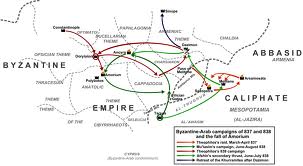|
The Byzantine Empire existed during, approximately, 306 AD to 1453 AD. It was one of the most powerful empires in Europe. They had a strong economy, culture, and an exceptional military force. This empire almost came to an end after the Byzantine-Arab wars. It lost territory and power.
It recovered during the Macedonian dynasty, rising again to become a huge power in the area by the 10th century. The Empire started to fall apart after 1071, when they lost the Empire's heartland to the Seljuk Turks. They managed some reestablishment with the reign of Andronikos I Komnenos, but after his death in the 12th century, the Empire started to decline again.

Arab tribes rebelled against Abu Bakr after he took leadership. The tribes, refused to follow or answer to anyone other than Muhammad. Many proponents to the new leadership believed that Ali, the son-in-law of the Prophet Muhammad should have been appointed their leader. This belief led to the Shia sect of the Muslim religion.
Abu Bakr insisted that allegiance to Muhammad meant loyalty to the Muslim state, of which he was the new head. This was the start of the Ridda Wars where Muslims reclaimed control and cleansed the budding empire. After restoring power and control of Arabia, Abu Bakr directed his eyes toward the Byzantine and Sassanid empires.

The Empire reached its lowest in 1204 by the Fourth Crusade, when it was divided into Byzantine Greek and Latin realms through civil wars. Even though there were more attempts of recuperation, civil wars kept raging and destroying the empire. Most of its remaining territories were lost in following Wars, which ended with the Fall of Constantinople. After this, the Byzantine Empire was in hands of the Muslim Empire, ending once and for all, the 1000 years of rule.

In the 10th and early 11th centuries the three Byzantine Emperors - Nikephorus II Phokas, John Tzimiskes and Basil II managed to recapture a great part of the territory that was lost in the 7th and early 8th centuries but only temporarily. Basilís successors were unable to follow his politics, while the expedition of Michael IV the Paphlagonian to recapture Sicily from the Arabs in 1038 failed.
The initial conflict lasted from 634 to 718, ending with the Second Arab Siege of Constantinople that halted the rapid expansion of the Arab Empire into Anatolia. Conflicts however continued between the 9th century and 1169. The Abbassid caliphate occupied territories in Southern Italy and Sicily in the 9th and 10th centuries.
However, under the Macedonian dynasty, the Byzantines recaptured territory in the Levant with the Byzantines armies' advance even threatening to retake Jerusalem to the south. The Emirate of Aleppo and its neighbours became vassals of the Byzantines in the east, where the greatest threat was the Egyptian Fatimid kingdom.
|

![]()


